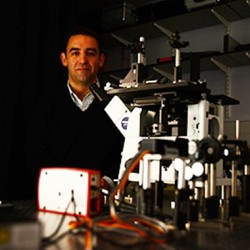 New insight into DNA replication and repair enzymes
New insight into DNA replication and repair enzymes
Albert Einstein once said: “Look deep into nature, and then you will understand everything better.” The beauty with single-molecule microscopy is that it allows just that – an invitation to explore biological events at atomic resolution. Now, new research from the CSC reveals how a single-molecule perspective can offer new insight into the way DNA is replicated and repaired.
Published in Nucleic Acids Research, Professor David Rueda (Single Molecule Imaging Group) partnered up with DNA replication expert, Louis Romano (Wayne State University, Detroit) to examine, at the single-molecule level, an enzyme involved in repairing DNA, known as DNA polymerase IV (Dpo4). Belonging to the Y-family polymerases, Dpo4 possess a unique feature allowing them to synthesize DNA past carcinogenic-damaged bases.
While, Dpo4 is known to utilize damaged DNA as a template, the exact mechanisms remain unclear. Two crystal structures were recently published: the first, showed Dpo4 with the DNA terminus bound at the catalytic site, thus blocking the site where a nucleotide would enter to allow DNA synthesis to occur; the second structure, was solved in the presence of the next correct nucleotide (correctly base-pairing with the template) and showed that the polymerase had backed up one position allowing the nucleotide to be positioned into the active site. “The two structures suggest that the polymerase has to be able to move on the DNA to accommodate the binding of the nucleotide in the active site. As such a motion would be very, very small and relatively fast, it would almost certainly be missed with standard biochemical experiments. At the at the single molecule level, however, we were able to capture the movement, and what we found was quite striking,” explains David.
Contrary to what was believed before, the team showed that Dpo4 actually binds to the DNA in an ‘open active site’ conformation (active conformation), before very rapidly moving to a position where the active site is blocked by the DNA terminus (inactive conformation). Subsequently, when the next correct nucleotide binds to the polymerase, the active conformation is regained, allowing the nucleotide into the active site and DNA synthesis to continue. In terms of DNA replication fidelity, the team noticed that incorrect nucleotides (those not correctly base pairing with the template) caused the Dpo4 complex to fall apart, a process most likely in place to ensure correct nucleotide selection. Most interestingly, if the nucleotide that pairs with the template one position past the active site was present, a slipped displaced structure was observed, which is consistent with the deletions often obtained during synthesis by this polymerase.
Understanding this mechanism is particularly important in the context of carcinogenesis (when normal cells are transformed into cancer cells). “Our results explain very nicely how damage to the DNA from carcinogens can be accommodated to allow the polymerase to continue.” Moving on from such mechanistic and fundamental study, the team are now keen to extend this technique to more complex systems, with the aim of understanding more human-like systems.
YJ
Reference: Brenlla, A., Markiewicz, R. P., Rueda, D., & Romano, L. J. (2014). Nucleotide selection by the y-family DNA polymerase dpo4 involves template translocation and misalignment. Nucleic Acids Research, 42 (4), 2555-2563.
This work was supported by the National Institutes of Health (NIH), National Science Foundation CAREER Award and a Fundación Barrié Fellowship.
The Medical Research Council has been at the forefront of scientific discovery to improve human health. Founded in 1913 to tackle tuberculosis, the MRC now invests taxpayers’ money in some of the best medical research in the world across every area of health. Twenty-nine MRC-funded researchers have won Nobel prizes in a wide range of disciplines, and MRC scientists have been behind such diverse discoveries as vitamins, the structure of DNA and the link between smoking and cancer, as well as achievements such as pioneering the use of randomised controlled trials, the invention of MRI scanning, and the development of a group of antibodies used in the making of some of the most successful drugs ever developed. Today, MRC-funded scientists tackle some of the greatest health problems facing humanity in the 21st century, from the rising tide of chronic diseases associated with ageing to the threats posed by rapidly mutating micro-organisms. www.mrc.ac.uk
